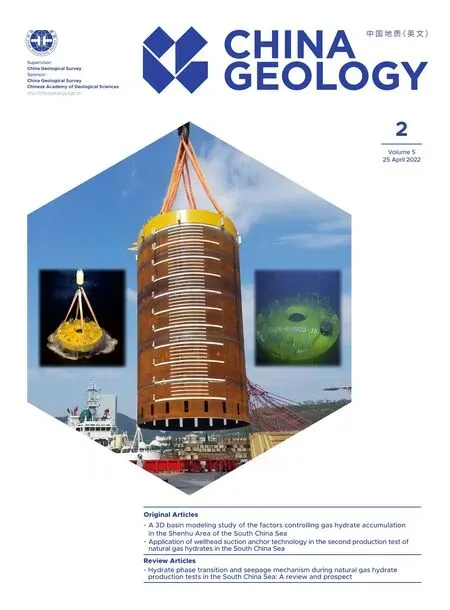Formation mechanism, experimental method, and property characterization of graindisplacing methane hydrates in marine sediment: A review
Yong-chao Zhang , Le-le Liu , Gao-wei Hu , Qing-tao Bu , Cheng-feng Li , Zheng-cai Zhang,Jian-ye Sun , Chang-ling Liu ,*
a The Key Laboratory of Gas Hydrate, Qingdao Institute of Marine Geology, China Geological Survey, Ministry of Natural Resources, Qingdao 266237, China
b Laboratory for Marine Mineral Resources, Pilot National Laboratory for Marine Science and Technology, Qingdao 266237, China
Keywords:
Methane hydrates
Formation mechanism
Grain-displacing hydrate
Pore-filling hydrate
Synthesis method
Sedimentary property
Oil and gas exploration engineering
NGHs exploration trial engineering
A B S T R A C T
Grain-displacing hydrate deposits exist at many marine sites, which constitute an important part of methane hydrate resources worldwide.Attributed to the difficulties in acquiring field data and synthesizing experimental samples, the formation and property characterization of grain-displacing hydrate remains less understood and characterized than the pore-filling hydrate in current literature.This study reviews the formation mechanisms of grain-displacing hydrate from the perspective of geological accumulation and microscale sedimentary property.The experimental methods of synthesizing graindisplacing hydrate in the laboratory and the current knowledge on the property of grain-displacing hydrate sediment are also introduced.Shortcomings in current theories and suggestions for future study are proposed.The work is hoped to provide valuable insights for the research into the hydrate accumulation,geophysics, and hydrate exploitation targeted at the grain-displacing hydrate in the marine sediments.
1.Introduction
Gas hydrates are ice-like compounds forms when water molecules and guest gas molecules combine in clathrate structures according to appropriate high-pressure and lowtemperature conditions (Boswell R and Collett TS, 2011;Waite WF et al., 2009).The predominant guest molecule in natural sediments is methane (CH4) which accounts for >80% of all categories, hence gas hydrate in natural is commonly called methane hydrates (MHs) (Boswell R et al., 2020).Some other low-molecular-weight gas, such as ethane (C2H6),dimethyl methane (C3H8), nitrogen (N2), and carbon dioxide(CO2), can also form gas hydrate (Sloan ED, 2003).Reported accumulations of hydrate-bearing sediment with exploration data have exceeded 60 sites worldwide, which are mainly distributed in the shallow sediments of continental margins and permafrost environments (Terzariol M et al., 2020; Wang HB et al., 2013; Wu NY, 2020).The reserves of MHs resources are conservatively estimated to be about 3000×1012m3of methane gas in place (calculated at standard temperature and pressure) based on the recent data ( Boswell R and Collett TS, 2011; Ruppel CD and Kessler JD, 2017).This value is smaller than that of about 120000×1012m3estimated by the early researchers (Klauda JB and Sandler SI,2005), but still much larger than that of conventional natural gas resources (about 404×1012m3) and shale gas resources(204×1012-456×1012m3) (Chong ZR et al., 2016).MHs have been the focus of much recent research aiming to solve the energy supply problem.To date, four production techniques including the depressurization method, thermal stimulation method, chemical inhibitor injection method, and gasexchange method have been proposed to target methane recovery from the hydrate-bearing sediments (HBS) (Cui YD et al., 2018; Li XS et al., 2016; Li YL et al., 2021; Yang L et al., 2019; Yin ZY and Praveen L, 2019; Zhang B et al., 2022).The depressurization method is considered the most economically feasible technique for hydrate resource development, which has been also successfully used in the production tests conducted in the Nankai Trough, Japan in 2013 and 2017 (Tamaki M et al., 2017; Yamamoto K et al.,2014) and the Shenhu Area of South China Sea, China in 2017 and 2020 (Li JF et al., 2018; Qin XW et al., 2020; Wu NY et al., 2011; Ye JL et al., 2020).Besides, attention has been paid to the environmental effects of MHs attributed to their potential role in evoking geohazards and climate change.Research on this topic has been comprehensively reviewed by Ruppel CD and Kessler JD (2017).
The formation of MHs refers to the nucleation process of water molecules and methane molecules and the subsequent growth of nucleated particles (Yin ZY et al., 2018).The formation process controls the distribution, occurrence,concentration, and accumulation of the sediment and also affects fluid transport properties and mechanical properties of the sediment (Cai JC et al., 2020b; Li YL et al., 2018; Ning FL et al., 2012).The occurrence of MHs means the morphology characteristics of MHs occupying the inner or between the sedimentary pores.Before the early 1980s, MHs was assumed to be uniformly distributed in the sediments wherever pressure and temperature conditions were appropriate (Milkov AV, 2004).After the 1990s, a number of ocean drilling expeditions, marine geological explorations,and laboratory visualization experiments proved that MHs deposits in marine sediments exhibit pronounced heterogeneity (Lei L et al., 2019; Li CF et al., 2019; Tréhu AM, 2006; Zhang YC et al., 2021c).These heterogeneous characteristics of MHs demonstrate the MHs concentration difference in the various hydrate strata and the difference in MHs occurrence morphology in sedimentary pores.From the results of ocean drilling expeditions, the occurrence of natural MHs is usually categorized into two types.One is the porefilling occurrence with MHs disseminated throughout the sedimentary pore spaces.Another is the grain-displacing occurrence with MHs present as veins, lenses, nodules, and chunks residing in the sediments (Dai S et al., 2012; Holland M et al., 2008).This category of hydrate occurrence indicates the differences in the formation mechanism of MHs in the sediments (as explained in Section 3).Coarse-grained sediments are typically reported to reserve pore-filling hydrate with a hydrate saturation higher than 20% and even up to 90%(Collett TS et al., 2012; Malinverno A and Goldberg DS,2015).The hydrate saturation in fine-grained sediments is usually low with the saturation of pore-filling hydrate being about 10% or less as well as the saturation of grain-displacing hydrate ranges from <5% to about 40% (Holland M et al.,2008; Lee MW and Collett TS, 2009).The hydrate resource pyramid as shown in Fig.1 plotted by Boswell R and Collett TS (2011) presents the reserves of different types of hydrates in various sediments.It shows that massive deposits of gas hydrate are encased in the fine-grained muds and shales with pore-filling occurrence meanwhile the reserves of pore-filling hydrate in coarse-grained sands and grain-displacing hydrate in fine-grained sediments merely account for small percentages of all categories.To date, the pore-filling hydrate in coarse-grained sands is still the main target of the current research, hydrate exploitations, and production tests.This mainly relates to its high quality in the hydraulic property and mechanical stability of sediment.However, the resource reserved in the grain-displacing hydrate is also enormous and has the potential for gas production in the long term (Chen Q et al., 2020).Hence the studies on the formation of the graindisplacing hydrate are worth and would be helpful for the exploration and development of this category of hydrate in the future.
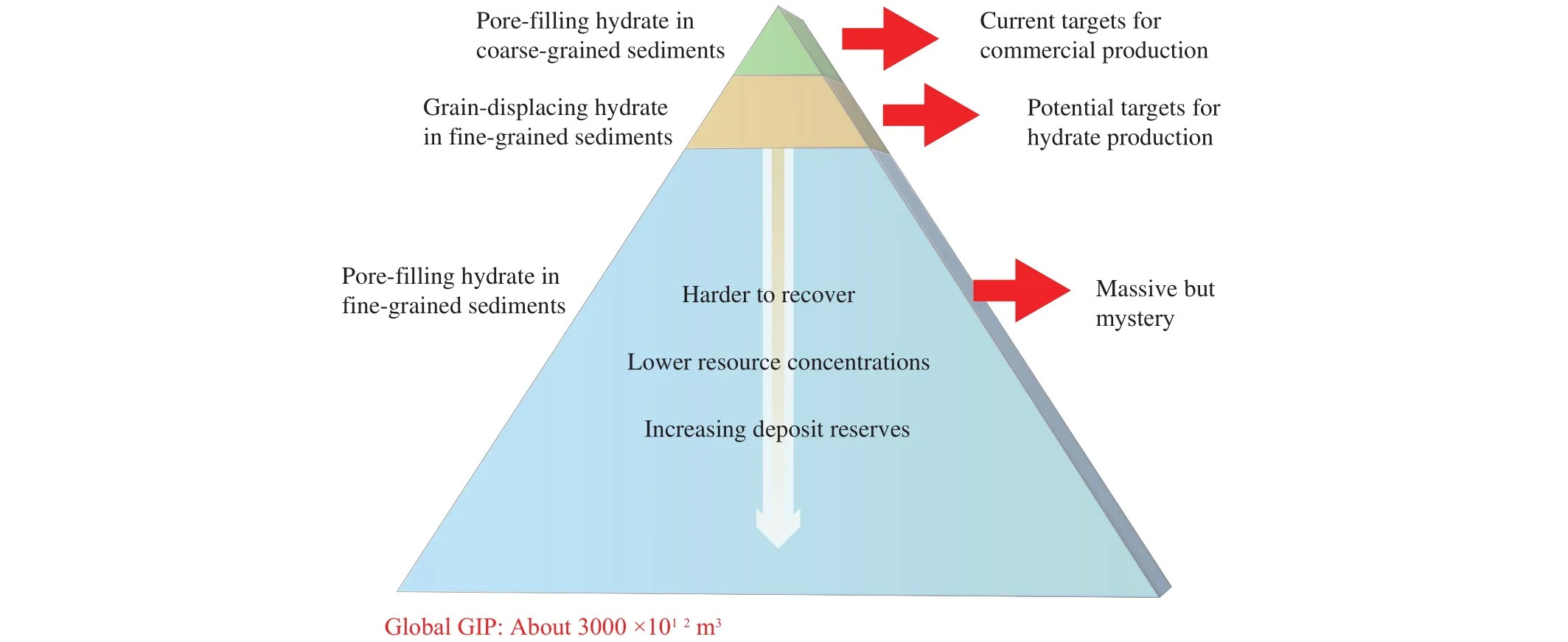
Fig.1.The gas hydrate resources pyramid (revised from Boswell R and Collett TS, 2011).
In this article, the authors reviewed three aspects concerning grain-displacing hydrate including the formation mechanism, synthesis methods in the laboratory, and its sedimentary properties.The formation mechanism is introduced from the viewpoints of the geological accumulation and microscale sedimentary property,respectively.Discussions and suggestions are given based on the understanding in the end.Besides, it should be noted that the formation of grain-displacing hydrate has a close relationship with the pore-filling hydrate.Some descriptions in this review are made comparatively with these two categories of hydrates.
2.Formation of grain-displacing hydrate
2.1.Hydrate formation within the hydrate stability zone (HSZ)
The methane HSZ indicates the strata where pressure and temperature allow the formation of methane hydrate if sufficient methane gas and water are present (You KH et al.,2019).The gas resource supporting the MHs formation comes from the microbial methane from shallow sediments and thermogenic methane from deep sediments (Milkov AV,2004; Wu NY, 2020).In a geological system, methane gas contributing to the hydrate formation can be supplied by effects of advection, diffusion, or a combination of the two.Common supply forms include diffusion of dissolved gas in liquid water, advection of free gas, and advection of dissolved gas by pore water flow.The contents of various phases(hydrate, water, and gas) within the HSZ are controlled by the correlations of temperature and pressure versus hydrate stability boundary as well as methane concentration versus methane solubility in pore water (Daigle H and Dugan B,2011, Zhang XD et al., 2021).MHs form when the methane concentration in the pore water exceeds the methane solubility within the HSZ.In a diffusion-dominated system, methane gas is disseminated in the sedimentary pores; the formation rate of hydrate is slow which is controlled by the methane concentration gradients and diffusion coefficients.The origin of an advection-dominated system is typically accompanied by the high-permeability paths composed of coarse-grained particles, fractures caused by the crustal tectonic activity, and the lateral compression deformation of marine sediments.In the advection-dominated system, hydrate deposits at a relatively fast rate which is controlled by the pressure gradients and sedimentary permeability (Liu XL and Flemings PB, 2007; Su PB et al., 2021; Xu WY and Ruppel CD, 1999).Previous literature reported that thin layers of hydrate generally accumulate in a diffusion-dominated system while thick zones of hydrate usually form in the advectiondominated system (Xu WY and Ruppel CD, 1999).However,the possible correlations between pore-filling hydrate/graindisplacing hydrate and diffusion-dominated system/advection-dominated system have not been validated with sufficient exploration data.
You KH et al.(2019) categorized MHs occurrence into five types based on their occurrence morphology and the geological environment in which they occur.They are Type 1,regionally disseminated low-concentration hydrate in muddy sediments; Type 2, fracture-filling hydrate at non-vent sites;Type 3, enriched hydrate at the BHSZ in muddy sediments;Type 4, concentrated hydrate at vent sites; and Type 5,concentrated hydrate in sand-rich intervals (plotted in Fig.2).Grain-displacing hydrate forms in both Type 1 and Type 2 occurrence.However, the grain-displacing hydrate enclosed in Type 1 can span only a few tens of meters while that in Type 2 can span kilometers when it relates to specific stratigraphic horizons (Boswell R et al., 2012; Cook AE et al.,2014).And the saturation of grain-displacing hydrate in Type 1 (less than about 10%) is generally lower than that of Type 2(several percent to less than about 50%) (Cook AE et al.,2010).Some vent sites often contain high-concentrated hydrate with an occurrence of grain-displacing (Type 4).Hydrate in this type fills the fractures in muddy sediments with the saturation ranging from about 40% to about 90%(Matsumoto R et al., 2017; Torres ME et al., 2004; Tréhu et al., 2004).Besides, the coarse-grained, sand-rich, sediments typically contain high-concentrated hydrate in an occurrence of pore-filling (Type 5).The saturation of pore-filling hydrate in Type 5 is usually larger than the pore-filling hydrate in Type 1 and Type 3.To conclude, the five occurrence types summarized by You KH et al.(2019) proved that the hydrate occurrence can be influenced by multiple geological factors which may include sedimentary property, geological structure, and gas resource.
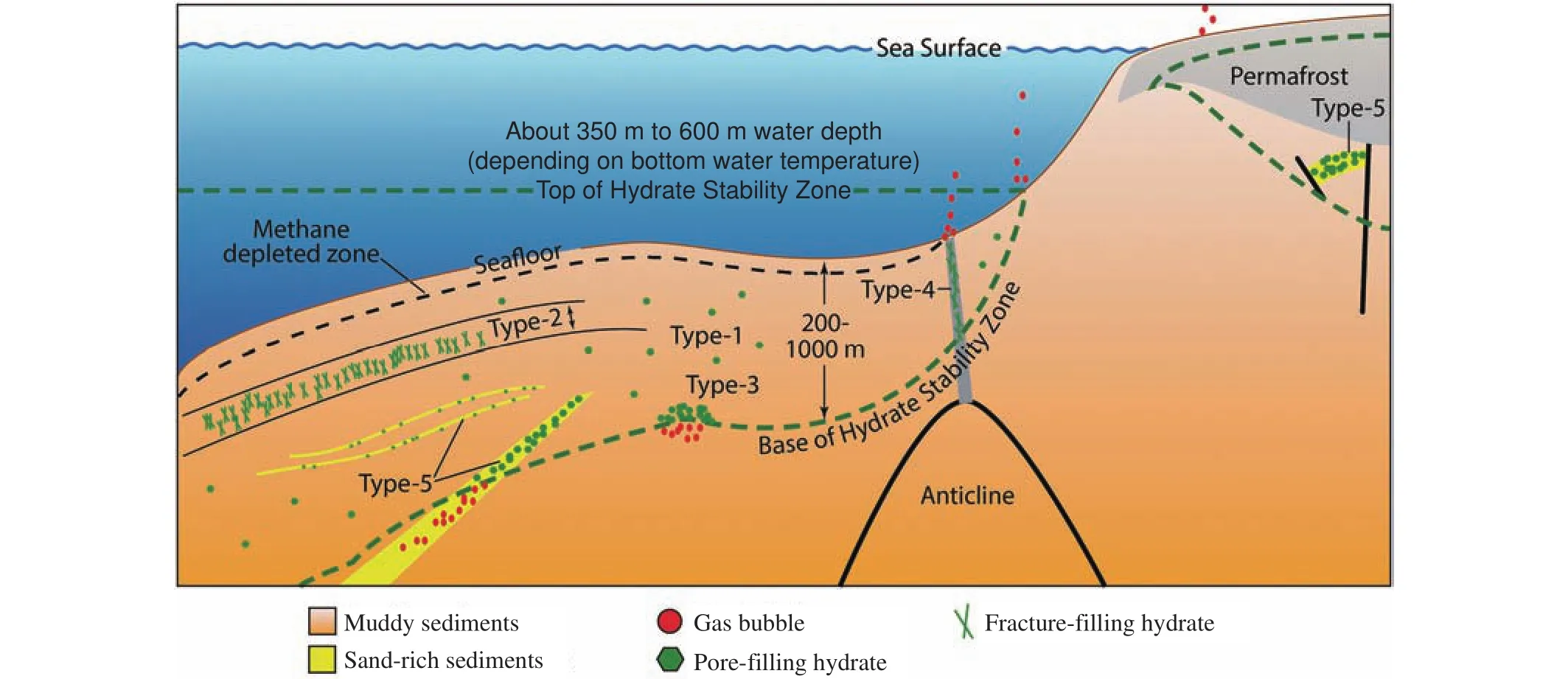
Fig.2.Five types of gas hydrate occurrences in a geological system (after You KH et al., 2019).
2.2.Microscale knowledge on the grain-displacing hydrate formation
From the perspective of the microscale mechanism, the formation process of hydrate in the pores was introduced as follows.According to the theory of hydrate kinetics, hydrate formation can be considered a time-dependent crystallization process that includes two cohesive stages: Hydrate nucleation and hydrate growth (Englezos P et al., 1987; Sloan JED and Koh CA, 2007).Hydrate nucleation is the process where small hydrate crystals (nuclei) grow and disperse in an attempt to achieve the critical size ensuring subsequent growth (Sloan JED and Koh CA, 2007).The critical size for MHs nucleation is around the order of about ten nanometers.In the hydrate formation experiments, hydrate nucleation is reflected as the induction time.Owing to that the hydrate nucleation is controlled by complicated microscopical factors,such as impurities in the pore fluids (e.g.clays, nanobubbles,and microorganisms), temperature, and previously dissociated hydrate structures, hydrate induction time in the formation process is usually stochastic with limited predictability (Sloan JED and Koh CA, 2007; You KH et al., 2019).Hydrate nucleation prefers to occur at the interface between the gas phase and water phase where low Gibbs free energy and high concentrations of gas molecules and water molecules are presented (Tohidi B et al., 2001).Otherwise, hydrate nucleation happens at stochastic locations when there is no obvious water-gas interface presented.
Hydrate growth begins after nucleation.In sediment,hydrate growth can be subdivided into two stages: Hydrate growth inside independent pores and hydrate growth between connected pores.Firstly, hydrate stable nuclei formed during the nucleation process continue to grow inside the independent-pore space.Owing to the Ostwald-ripening effect, dispersed hydrate particles in the pore are concentrated into fewer, larger particles (Myerson A, 2002).This process develops and eventually becomes constrained by the mineral grains.Further hydrate growth between connected pores determines the occurrence of hydrate.On this issue, a persuasive viewpoint was proposed by Dai S et al.(2012) and widely accepted by other researchers (Lei L and Santamarina JC, 2018; Terzariol M et al., 2020).Dai et al., (2012).believed that the hydrate occurrence in sediment was determined by the growth of hydrate outside the original pore space; whether growth occurs in a pore-filling manner or grain-displacing manner depends on the balance between the local effective stress and the capillary pressure developed by the hydrated mass(Fig.3).At equilibrium, the pressure in the hydratePhbalances the pressure in waterPwand the effective stress acting on the mineral grain σ′, shown as

Fig.3.A schematic diagram of the hydrate formation in the manner of pore-filling and grain-displacing.

The pressure difference between the hydrate phase and water phase on the interface was considered as the capillary pressurePcpand calculated by the Laplace-Young equation(Eq.2) in Dai et al., (2012) work.

where γhwis the interfacial tension between hydrate and water,θis the contact angle,dthis the diameter of pore throat, which can be roughly estimated byis the diameter of the finest 10thpercentile grains in the grain size distribution.Based on Eq.1 and Eq.2, a dimensionless parameter ψ was proposed by Dai S et al.to reflect the balance between hydrate-water capillary pressure and effective pressure, expressed as

When ψ >1, capillary pressure prevails and the hydrate can displace the mineral grains more readily than invade the neighboring pore space.In this case, hydrate is more likely to form grain-displacing hydrate.In contrast, ψ <1 corresponds to the condition that effective pressure prevails and hydrate prefers to grow outside the original pore by invading the neighboring pores.Thus, hydrate is more likely to form porefilling hydrate occurrence.
To validate the application ψ in predicting the hydrate occurrence, Dai et al., (2012) analyzed the hydrate occurrence of 28 sets of natural samples from HBS in terms of the effective stress versus grain particle size.They found that pore-filling hydrate occurrence corresponds to a condition of large grain particle and high effective stress for which ψ<0.001; grain-displacing hydrate with nodules/chunks occurrence mainly occurs in the sediment with small grain particle size and low effective stress where ψ>1.In the intermediate condition of 0.001<ψ<1, hydrate forms in the grain-displacing pattern with lenses/veins occurrence.The theoretical method proposed by Dai et al., (2012) basically shows good consistency with the natural observations.Terzariol M et al.(2020) validated Dai et al., (2012) theory with more samples.They further found that the hydrate occurrence in HBS is also controlled by the fine fraction of the marine sediment except for the capillary pressure and depth-dependent local effective stress.
2.3.Shortcomings in current theories
Some contradictions or shortcomings in the formation theories of grain-displacing hydrate as introduced in Sections 2.1 and 2.2 need to be further discussed.One is about the origin and attribute of the hydrate pressure (Ph) in Dai et al.,(2012) theory.Dai et al., (2012) assumed that the pressure difference betweenPhandPwcould be expressed as the capillary pressure (Pcp) which was directly calculated by the Young-Laplace equation as shown in Eq.2.The Young-Laplace equation is typically used for calculating the capillary pressure between two liquid phases in the solid porous media.However, hydrate in the sedimentary pores is also a solid phase.Whether the interfacial tension between the solid hydrate and pore water can be calculated by the Young-Laplace equation is questionable.In the authors’ opinion,Phmay be caused by the difference of interfacial tension between different phases, but more likely caused by the volume expansion during the process of the water phase turning into the hydrate phase, or a combinationof these two effects.Another contradiction exists in the correlation between the microscale theory and geological accumulation understandings.For example, in some reported data,concentrated grain-displacing hydrates were found in the upper part of the gas chimney structure and the interior of the fault structure; the scale of the grain-displacing hydrate accumulations in these areas can span kilometers (Lee MW and Collett TS, 2009; Matsumoto R et al., 2017; Torres ME et al., 2004; Tréhu AM et al., 2004).Microscale theories are obviously not able to determine the largest scale of graindisplacing hydrate accumulations formed in the strata.Thus,questions like whether the existed fracture-pore spaces contribute to or affect the formation of grain-displacing hydrate have not been clarified.In this regard, a consistent cross-scale theory combining microscale with geological viewpoints is needed for fully understanding the formation mechanisms of hydrate with different occurrences.Moreover,a small amount of clays in the sediments can significantly alter the pore-size, mechanical, water properties, and wettability properties within the sediment (Aksu I et al., 2015;Bourg IC and Ajo-Franklin JB, 2017).It means that the influences of clay contents would affect the capillary pressure and the deformation of pore-structures during the hydrate formation in a nonlinear way.Hence the influence of clay on the formation of grain-displacing hydrate should be included in further studies.
3.Synthesis methods of grain-displacing hydrate in the laboratory
Attributed to the obstacles in drilling, transporting, and preserving the natural hydrate-bearing samples, most of the property analyses of hydrate-bearing sediments were completed using artificial samples synthesized in the laboratory (Liu LL et al., 2021a).Commonly-used experimental methods of synthesizing MHs include the dissolved gas method, partial water saturation method, iceseeding method, and hydrate premixing method (Waite WF et al., 2009).The working principles of these experimental methods are that water and methane gas would convert into hydrate when the surrounding temperature and pressure are located in the formation zone of the phase equilibrium curve(Fig.4) (Wu NY et al., 2018).Previous works have proved that the above five methods are feasible for synthesizing porefilling hydrate under laboratory conditions (Lei L and Seol Y,2019; Malagar BRC et al., 2019).However, rare synthetic experiments of grain-displacing hydrate were reported.According to the formation mechanisms introduced in Section 2, grain-displacing hydrate forms when the effective stress in the sediment exceeds the capillary pressure built in the pore spaces.This means that fine-grained sediment is requisite for synthesizing grain-displacing hydrate.However, synthesizing hydrate in fine-grained sediment is hard to accomplish in the laboratory.One reason for that is the small-size particles induce low water activity in the pore spaces (Qin Y et al.,2021).In this case, the nucleation of hydrate requires lower temperature and higher pressure to overcome the large contributions of surface energy to the total free energy of small particles.Fig.4 shows the phase equilibrium curve of hydrate to high pressure and low temperature with the decreasing particle size.Another reason is that the narrow throats and complex flowing paths in fine-grained sediment would lower the gas supply efficiency which slows down the growth rate of hydrate (Englezos P et al., 1987; Lei L and Santamarina JC, 2018).
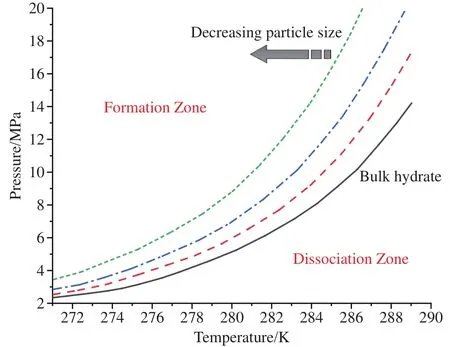
Fig.4.Diagram of the phase equilibrium curves for bulk hydrate and hydrate in the porous sediments with different particle sizes(modified from Lei L, 2017).
Comparisons of the five experimental methods in terms of their applicability in synthesizing grain-displacing hydrate have been listed in Table 1.The dissolved gas method is obviously not suitable for synthesizing grain-displacing hydrate in fine-grained sediment due to its low rate of hydrate formation (Buffett BA and Zatsepina OY, 2000).The formation rate using the partial water saturation method is faster compared to the dissolved gas method.The feasibility of synthesizing grain-displacing hydrate using a modified partial water saturation method was reported by Lei L and Santamarina JC (2018).However, the formed grain-displacing hydrates using Lei L and Santamarina JC’s scenario are mainly distributed at the interfaces between the invaded gas and the water-saturated sediment (Lei L and Santamarina JC,2018), of which the occurrence may be different from that formed in natural sediments.Ice-seeding method and hydrate premixing method are the commonly-used methods of synthesizing grain-displacing hydrate in current research.These two methods are performed by mixing cooled sedimentary grains with small ice particles or preformed hydrate particles at a low temperature, and then adjusting the pressure and temperature conditions to facilitate the melt of the ice particles or hydrate particles and further formation of hydrate with targeted occurrence.Two advantages of these two methods are (1) MHs with high saturation can be synthesized within a short time and (2) grain-displacing hydrates with different occurrences including nodules,chunks, lenses, and veins can be easily obtained by changing the buried positions of ice particles or preformed hydrate particles (Fig.5).In addition to these two methods, the analog hydrate method has been also used for synthesizing graindisplacing hydrate in some works.Commonly-used guestmolecule materials used for synthesizing hydrate analogs include tetrahydrofuran (C4H8O, liquid, referred to as THF),Xenon gas (Xe), and CO2gas (Lei L and Santamarina JC,2018; Liu ZC et al., 2019).The required temperature and pressure conditions for converting these guest-molecule materials into hydrates are much easier to implement than that of methane gas (Anderson R et al., 2003; Rasoolzadeh A et al., 2020).Thus, the formation of grain-displacing hydrate in fine-grained sediments can be completed within a relatively short time.However, the occurrence and property of these hydrate analogs show some distinctions compared to MHs(Lee JY et al., 2007).

Table 1.Experimental synthesis methods of hydrate in porous sediments.
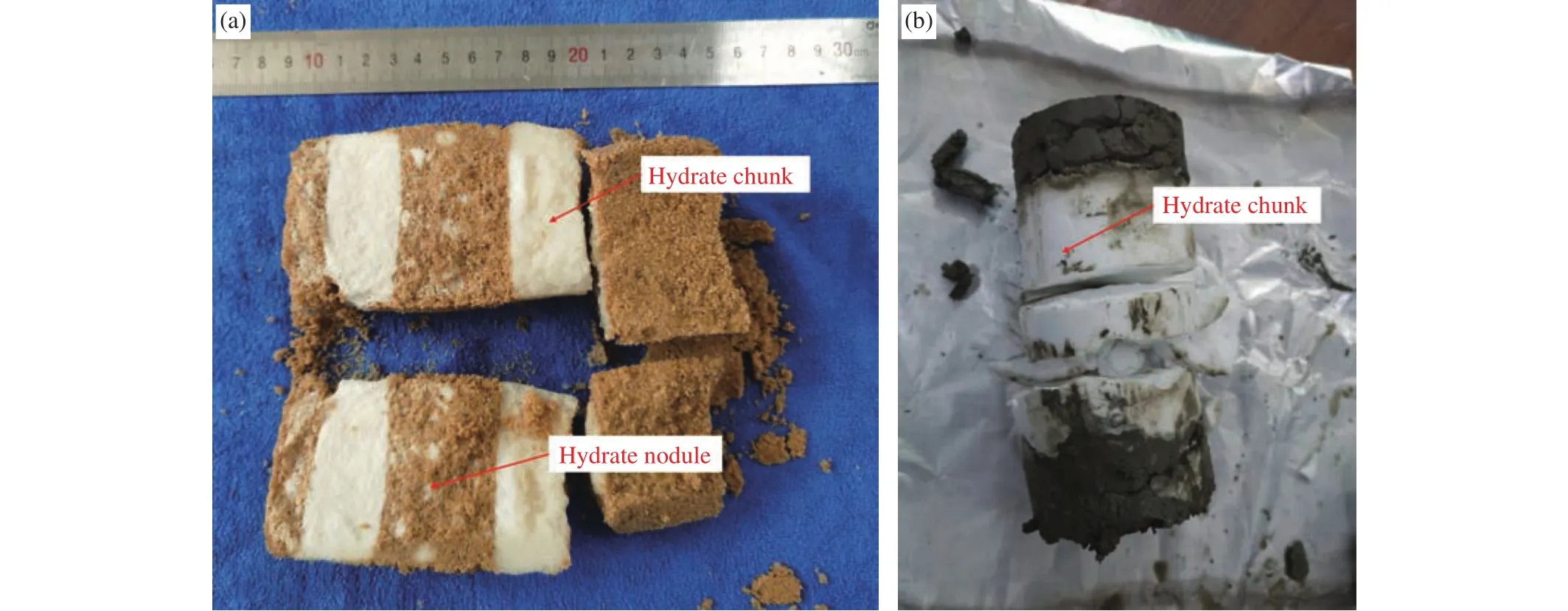
Fig.5.Synthesized grain-displacing hydrate using the ice-seeding method in the authors’ previous work.a- synthesized hydrate nodule/chunk in coarse-grained sediment; b-synthesized hydrate chunk in fine-grained sediment.
4.Properties of the grain-displacing hydrate sediment
Attributed to the difficulties in synthesizing graindisplacing hydrate in the laboratory, the property of the graindisplacing hydrate sediment is also less revealed in the literature compared to pore-filling hydrate.Scarcely reported works related to the property of the grain-displacing hydrate sediment mainly focus on the electrical and acoustic responses of the HBS.It is generally assumed that the electrical resistivity, P-wave velocity, and S-wave velocity of the HBS including both pore-filling and grain-displacing hydrate are larger than that of the water-saturated sediments(Hu GW et al., 2014, 2010; Li YL et al., 2020; Spangenberg E and Kulenkampff J, 2006; Winters WJ et al., 2007).This feature has been widely used in the well logging for evaluating marine hydrate reserves.However, the heterogeneity of hydrate occurrence and distribution leads to the logging curves of the HBS with grain-displacing hydrate behaving differently from that of pore-filling hydrate.
Wang JL et al.(2013) and Wang XJ et al.(2021) reported that sediments with grain-displacing hydrate in a low saturation present higher electrical resistivity but similar P-wave velocity compared to the water-saturated sediments; the electrical resistivity and P-wave velocity of sediment increase to abnormally high values when hydrate saturation is larger than 40%.Many rock-physics models have been proposed and used for correlating the hydrate saturation with acoustic velocity, which include the Wyllie model (Wyllie MRJ et al.,1958), the weighted three-phase model (Lee MW et al., 1996),the Effective medium model (Dvorkin J et al., 1999), and BGTL (Boit-Gassmann theory modified by Lee MW et al.,1996) model (Lee MW, 2002).For the reason that the heterogeneous occurrence of MH was not considered in these models, the predicted hydrate saturation obtained from models fit well with the natural sediments for pore-filling hydrate but was much higher than that of natural sediments for grain-displacing hydrate (Lee MW and Collett TS, 2009).To describe the occurrence of grain-displacing hydrate,several improved methods have been proposed based on the previous rock physics models.Typical examples include the layered medium model treating the sediment as two separated components (Wang JL et al., 2013, 2017) and the combined method using P-wave velocity and density properties (Jing PF et al., 2020; Liu T and Liu XW, 2018), which are both reported to agree well with the grain-displacing hydrate sediment.However, validations of these models/methods were conducted by comparing the model predictions with the well-logging results from the HBS.The accuracy of the model predictions can be largely dependent on the parameter settings in the calculation.Experimental studies of the electrical and acoustic characteristics of grain-displacing hydrate sediment combined with theoretical model analysis might provide more accurate results (Bu QT et al., 2021).Moreover, other physical properties of sediment with grain-displacing hydrates such as mechanical properties, thermodynamic properties,seepage properties of fluids are also important for the exploration and development of grain-displacing hydrate resources (Cai JC et al., 2020a; Liu LL et al., 2019; Ren XW et al., 2020).Works focusing on these properties have not been reported in previous studies.
5.Conclusions
Salient conclusions obtained from this review and suggestions for future study include:
(i) The formation process of grain-displacing hydrate has been studied from two different viewpoints in current literature.From the macroscopic viewpoint, the geological analyses mainly explain the distributions of grain-displacing hydrates around the HSZ.From the microscopic viewpoint,the sedimentary property is assumed to be the controlling factor of hydrate occurrence.More specifically, hydrate tends to form grain-displacing hydrate when the capillary pressure prevails over the local effective stress in the sediment.However, current theories of grain-displacing formation show shortcomings in the aspect of the origin of the hydrate pressure, the largest scale of hydrate forming in the manner of grain-displacing, and the influence of clay on hydrate occurrence.A consistent theory combing geological understandings with microscopic mechanical understandings is necessary for fully explaining the formation mechanisms of grain-displacing hydrates.
(ii) Synthesis methods including the ice-seeding method,hydrate premixing method, and analog hydrate method have been proved feasible for synthesizing grain-displacing hydrate in the laboratory.The differences between these synthesized hydrates and the hydrates in natural sediment still need to be clarified.In addition to the above methods, reproduction of the formation process of grain-displacing MH using the method of controlling the sedimentary grain size and effective stress is worth trying.Furthermore, some microscope processes controlled by the intermolecular forces during the process of grain-displacing hydrate formation are difficult to be detected using common laboratory techniques.In this case,molecular dynamics simulation may provide support for the analyses of hydrate formation mechanisms (Anderson BJ et al., 2005; Zhang ZC et al., 2020, 2018, 2016).
(iii) The property of the grain-displacing hydrate sediment is scarcely revealed in current studies.A few existing studies merely found that the electrical resistivity and acoustic responses of the grain-displacing hydrate sediments show some differences from that of pore-filling hydrate sediments owing to the heterogeneity of grain-displacing hydrate occurrence and distribution.To better describe the quantitative correlations between electrical/acoustic responses and hydrate content in the sediment, the petrophysical models are recommended to combine with physical experiments.Based on a better understanding of the formation process and synthesis method, further studies on the other sedimentary properties of grain-displacing hydrates would be the key issue for the commercial development of grain-displacing hydrate resources.In this scenario, microscopic detecting techniques including X-ray computed tomography (X-CT) (Zhang YC et al., 2021b), low-field nuclear magnetic resonance (LF-NMR)(Ji YK et al., 2019; Liu LL et al., 2021b; Zhang YC et al.,2021a) may be helpful.
CRediT authorship contribution statement
Yong-chao Zhang: Conceptualization, methodology,writing-original draft, funding acquisition; Le-le Liu:Conceptualization, validation, writing-review and editing;Gao-wei Hu: Resources, validation, writing-review and editing; Qing-tao Bu: Resources, data curation; Cheng-feng Li: Visualization, formal analysis, writing-review and editing;Zheng-cai Zhang: Conceptualization, writing-review and editing; Jian-ye Sun: Formal analysis, data curation, funding acquisition; Chang-ling Liu: Writing-review and editing,supervision, project administration, funding acquisition.
Declaration of competing interest
The authors declare no conflicts of interest.
Acknowledgment
This work is supported by the National Natural Science Foundation of China (42006181, 42176212, 41976205,41876051), the Youth Foundation of Natural Science Foundation of Shandong Province (ZR2020QE109), the National Key Research and Development Project(2018YFE0126400), and the Marine S&T Fund of Shandong Province for Pilot National Laboratory for Marine Science and Technology(Qingdao)(2021QNLM020002).
- China Geology的其它文章
- China achieved fruitful results in oil-shale gas-coalbed methane exploration and development in 2021
- Molecular simulation studies on natural gas hydrates nucleation and growth: A review
- Distributed optical fiber acoustic sensor for in situ monitoring of marine natural gas hydrates production for the first time in the Shenhu Area, China
- Experimental investigation of hydrate formation in water-dominated pipeline and its influential factors
- Stability analysis of seabed strata and casing structure during the natural gas hydrates exploitation by depressurization in horizontal wells in South China Sea
- Application of wellhead suction anchor technology in the second production test of natural gas hydrates in the South China Sea

